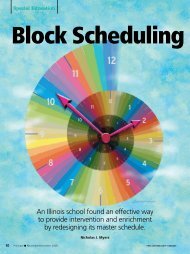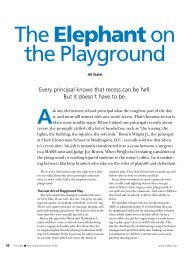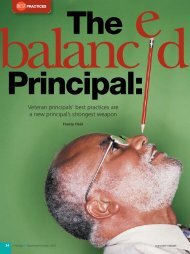The Case for Teacher-led School Improvement - National ...
The Case for Teacher-led School Improvement - National ...
The Case for Teacher-led School Improvement - National ...
Create successful ePaper yourself
Turn your PDF publications into a flip-book with our unique Google optimized e-Paper software.
the many hats of the principal<br />
<strong>The</strong> <strong>Case</strong> <strong>for</strong><br />
<strong>Teacher</strong>-<strong>led</strong><br />
<strong>School</strong><br />
<strong>Improvement</strong><br />
LaQuanda Brown<br />
Principals’ expanded roles and responsibilities<br />
can be shared with teacher leaders.<br />
28 Principal n March/April 2008 Jack Hollingsworth/Punchstock
One of the new buzz phrases in education is “teachers<br />
as leaders.” While this term intrigues educational professionals,<br />
it is not a term that should be used loosely.<br />
Marzano, Waters, and McNulty (2005) contend that leadership<br />
is considered to be vital to the successful functioning of many<br />
aspects of a school. <strong>The</strong>re<strong>for</strong>e, retaining effective teachers and<br />
developing them into leaders is essential <strong>for</strong> school improvement,<br />
which will ultimately lead to school success. And given<br />
the expanded roles and responsibilities of principals, it is crucial<br />
that district and school administrators cultivate teachers to<br />
successfully share leadership responsibilities.<br />
Leithwood (1994) identifies the four<br />
I’s of school leadership—individual<br />
consideration, intellectual stimulation,<br />
inspirational motivation, and idealized<br />
influence—that are essential <strong>for</strong> schools<br />
to be successful in the 21st century.<br />
Leithwood’s four I’s are what he refers<br />
to as the elements of trans<strong>for</strong>mational<br />
leadership. In a school where the principal<br />
is focused on building the leadership<br />
influence of teachers, the principal<br />
must teach, exhibit, and train teachers<br />
on the intellectual stimulation of school<br />
leadership. Through the intellectualstimulation<br />
approach, the principal<br />
helps the school staff to have vision and<br />
<strong>for</strong>esight in looking at old problems in<br />
new ways by working together to create,<br />
identify, and implement innovative,<br />
workable solutions.<br />
Build Capacity and Consensus<br />
Administrators must build instructional<br />
capacity and instructional consensus<br />
among school staff. However,<br />
many administrators are still at a loss<br />
on how to accomplish this daunting<br />
task. <strong>The</strong> principal has to fulfill many<br />
complex administrative responsibilities<br />
each day. Some decisions must<br />
be made immediately, while other<br />
decisions may allow the principal to<br />
include input from teachers and other<br />
stakeholders. Gabriel (2005) writes<br />
that it is useful to let someone else propose<br />
the change and that the principal<br />
should not be the only person in the<br />
school to offer solutions.<br />
For example, there may be a concept<br />
that the principal truly believes in, such<br />
as building time into the school day<br />
during which every student and teacher<br />
is involved in independent reading.<br />
However, be<strong>for</strong>e the principal brings<br />
this proposal to the faculty, he or she<br />
should find out if other members of<br />
the school staff share this same philosophy.<br />
If other staff members share the<br />
principal’s philosophy, then the issue<br />
should be introduced to the staff as a<br />
capacity-building activity. In addition<br />
to teachers, custodians and other staff<br />
members may also agree with the proposal.<br />
If this is the case, staff members<br />
(other than the principal and teachers)<br />
may introduce the initiative to the faculty<br />
to begin critical conversations on<br />
implementing the instructional practice<br />
into the daily school program. Administrators<br />
must be cognizant of the fact<br />
that true school improvement involves<br />
everyone on the school staff, and must<br />
there<strong>for</strong>e incorporate every member of<br />
the staff in the decision-making process.<br />
IN BRIEF<br />
<strong>The</strong> author argues that principals<br />
must take the lead in trans<strong>for</strong>ming<br />
teachers into leaders and increasing<br />
the instructional capacity of schools<br />
by building consensus, creating a<br />
leadership team, and grooming teacher<br />
leaders.<br />
Develop a Leadership Team<br />
An additional component of creating<br />
an atmosphere of shared leadership,<br />
where teachers work collectively with<br />
administrators to implement researchbased<br />
instructional practices and<br />
methodologies, is to create an effective<br />
school leadership team. A strong and<br />
purposeful leadership team is able to<br />
adequately sustain the responsibilities<br />
and challenges of becoming an effective<br />
school. To create a strong leadership<br />
team, the principal must create an<br />
atmosphere of shared data collection<br />
and analysis, shared decision-making,<br />
and shared respect among the team.<br />
For example, the principal must create<br />
an environment where teachers<br />
feel com<strong>for</strong>table offering suggestions,<br />
asking questions, and providing feedback.<br />
In addition, the atmosphere must<br />
be conducive to teachers sharing the<br />
responsibility of identifying problems,<br />
offering viable solutions, and working<br />
collaboratively to create a plan to implement<br />
agreed upon solutions.<br />
DuFour, DuFour, Eaker, and Karhanek<br />
(2004) write about the power of<br />
collective intelligence, or the practice of<br />
professionals working collaboratively to<br />
solve problems within an organization,<br />
as well as the practice of “harnessing<br />
the power of collective intelligence<br />
that already resides in the school to<br />
solve problems.” Similarly, Marzano,<br />
Waters, and McNulty (2004) describe<br />
the concept of agreed-upon processes<br />
that “enhance communication among<br />
community members, provide <strong>for</strong> efficient<br />
reconciliation of disagreements,<br />
and keep the members attuned to the<br />
current status of the community.” This<br />
research reflects the well-known fact<br />
that successful schools have a culture<br />
of collaborative, sound, research-based<br />
decision-making practices that focus<br />
on the needs of the school. DuFour,<br />
DuFour, Eaker, and Karhanek (2004)<br />
note that “these schools made astonishing<br />
progress with existing amounts of<br />
time and funding. <strong>The</strong>y did not wait<br />
<strong>for</strong> someone from the outside to give<br />
them the magic <strong>for</strong>mula, the perfect<br />
program, or more resources.” Part of<br />
the culture of change and excellence<br />
www.naesp.org Principal n March/April 2008 29
involves a great deal of teacher collaboration<br />
and faculty ownership of the<br />
identified issues and possible solutions.<br />
Groom <strong>Teacher</strong> Leaders<br />
<strong>School</strong> principals must create a cadre<br />
of teacher leaders <strong>for</strong> each grade level<br />
and <strong>for</strong> each content area. <strong>The</strong> teacherleader<br />
selection process must be based<br />
on a variety of leadership traits and<br />
Preferred Educational Software<br />
221 Rivers Edge Drive - Dept. ES8<br />
Cherry Valley, IL 61016<br />
instructional qualities and must be equitable,<br />
nonbiased, and honest.<br />
More important, the teacher leaders<br />
and the members of the school’s leadership<br />
teams should have an innate desire<br />
to serve, should have a high level of<br />
commitment to the total functioning of<br />
the school, and should have a spirit of<br />
dedicated volunteerism.<br />
<strong>The</strong> principal should not be the only<br />
<strong>The</strong> Administrative Observer<br />
Document your observations quickly and easily<br />
Being an Administrator just got easier!<br />
Evaluations & observation summaries <strong>for</strong> any educational category<br />
Your terminology and evaluation criteria go into our software!<br />
On your desktop ...<br />
Or on your handheld ...<br />
Palm / Pocket PC / Windows Mobile<br />
Great <strong>for</strong> Walk-through observations!<br />
Point - Click - Done!<br />
New!<br />
Create school improvement and staff development plans<br />
by analyzing your classroom observation data.*<br />
* New in Professional edition<br />
All versions of Windows<br />
$295.00 (Standard Desktop edition)<br />
$495.00 (Professional Desktop edition)<br />
$99.95 (Optional handheld version)<br />
(Desktop edition required <strong>for</strong> handheld)<br />
Purchase Order, Credit Card, or Check<br />
Improving schools...<br />
One observation at a time!<br />
New!<br />
Toll Free (888) 959-2016<br />
FAX (815) 332-1639<br />
www.pes-sports.com<br />
person choosing the teacher leaders.<br />
A principal may choose to have the<br />
school staff nominate teacher leaders,<br />
or perhaps there may be a teacherleader<br />
nomination committee. <strong>Teacher</strong>s<br />
should also have the option to decline<br />
the opportunity to become a teacher<br />
leader without fear of consequence.<br />
Furthermore, the teacher-leader selection<br />
process should result in teacher<br />
leaders wanting to serve the school by<br />
taking part in the school-improvement<br />
group. Essentially, this practice gives<br />
teachers the opportunity to operate as<br />
joint and collaborative leaders.<br />
In order to build capacity <strong>for</strong> instructional<br />
know<strong>led</strong>ge and delivery, which<br />
ultimately will positively affect student<br />
achievement, there must be a system in<br />
place <strong>for</strong> ongoing training of effective,<br />
standards-based instructional planning,<br />
standards-based delivery, and standardsbased<br />
assessment. In addition, teacher<br />
leaders should be trained by a variety<br />
of experts, including the principal,<br />
assistant principal, instructional coach,<br />
district- or state-level content expert,<br />
district- or state-level instructional<br />
coordinator, and district- or state-level<br />
master teacher.<br />
<strong>The</strong> teacher leaders must also be provided<br />
the opportunity to train teachers<br />
within the school day. Trainings must be<br />
nonthreatening, collaborative, and datadriven.<br />
<strong>Teacher</strong>s should also be given<br />
opportunities to provide open and honest<br />
feedback on trainings. For instance,<br />
summative assessments may indicate<br />
that teachers need training on differentiated<br />
instruction or on delivering best<br />
instructional practices to students. <strong>The</strong><br />
teachers, however, may voice concerns<br />
on needing training that focuses on<br />
delivering quality, collaborative instruction<br />
or on the use of standards-based<br />
assessments and standards-based grading<br />
practices.<br />
<strong>The</strong>re<strong>for</strong>e, in order to build quality<br />
consensus, teachers must have a voice in<br />
the types of training offered by teacher<br />
leaders. Thus, teacher leaders should<br />
provide and implement quality training<br />
systems that offer a balance <strong>for</strong> classroom<br />
teachers and that answer to the<br />
data as well as to the teachers’ requests.<br />
30 Principal n March/April 2008<br />
www.naesp.org
2258_003_Ad.qxd:2197-006 12/13/07 6:52 PM Page 1<br />
“And given the<br />
expanded roles and<br />
responsibilities of<br />
principals, it is crucial<br />
that district and school<br />
administrators cultivate<br />
teachers to successfully<br />
share leadership<br />
responsibilities.”<br />
<strong>Teacher</strong>-<strong>led</strong> leadership includes the<br />
process of teachers analyzing, disaggregating,<br />
and conversing about students’<br />
achievement, attendance, and discipline<br />
data. In addition, a part of the data<br />
conversation must address cause, or the<br />
“why” questions. <strong>The</strong> “why” questions<br />
must be qualitative, substantial, and correlated<br />
to the ongoing data-collection<br />
process. This is a practice that is also not<br />
easy to master and may call <strong>for</strong> training.<br />
For instance, if the school-achievement<br />
data indicates high literacy and low<br />
math scores, it is not enough <strong>for</strong> teachers<br />
and administrators to know this<br />
fact. <strong>The</strong> team must work together to<br />
figure out why this is the case and what<br />
plan can be collaboratively created and<br />
implemented that speaks to the causes.<br />
For example, a “Needs <strong>Improvement</strong>”<br />
school that may also be involved<br />
in restructuring will require the school<br />
staff to have a central, daily focus on<br />
data collection and data analysis. Due<br />
to the status of the school’s progress,<br />
focusing on student-achievement data is<br />
a critical step to increasing student per<strong>for</strong>mance.<br />
Listed below are examples<br />
of some of the “why” questions that the<br />
school might use to help guide and<br />
in<strong>for</strong>m instruction:<br />
n Why are the male students scoring<br />
higher than the female students in<br />
science<br />
n Why are the female students<br />
not interested in the science<br />
curriculum<br />
n Why are the female students outper<strong>for</strong>ming<br />
the male students in<br />
reading<br />
n Why are the majority of the students<br />
at per<strong>for</strong>mance level 3 in<br />
science male<br />
n Why are the male students only<br />
interested in certain types of writing,<br />
such as writing poetry<br />
n Why are the students that are<br />
scoring the lowest on summative<br />
and <strong>for</strong>mative assessments also the<br />
students who miss the most school<br />
days during the course of the<br />
school year<br />
n Why is less than 10 percent of the<br />
total school population per<strong>for</strong>ming<br />
in the highest category of student<br />
achievement<br />
n Why are more of the fiscal resources<br />
being used to address the areas<br />
of low student per<strong>for</strong>mance<br />
<strong>The</strong>se are examples of the types<br />
of questions that must be asked and<br />
seriously considered by teachers and<br />
administrators to ensure that a school<br />
begins to focus and move into a largescale<br />
school-improvement planning and<br />
implementation phase.<br />
A Trusted Partner<br />
“ASCD offers its members great professional opportunities<br />
and ideas. I have been in the education profession <strong>for</strong> 40<br />
years and have attended ASCD’s Annual Conference many<br />
times. I have found the conference to be ‘A#1’ as far as<br />
major speakers and new ideas that help me address the<br />
needs of the Baltimore inner city middle schooler. <strong>The</strong> cost<br />
and benefits of the publications alone should convince any<br />
nonmember educator to join ASCD.”<br />
Eileen Clinton<br />
Eileen Clinton, I.H.M., Principal<br />
Mother Seaton Academy, Baltimore, MD<br />
ASCD Member, 10 years<br />
Join the Leaders, Join ASCD!<br />
Go to www.joinup.org/ascd914 to gain access to learning.<br />
Association <strong>for</strong> Supervision and Curriculum Development<br />
1703 North Beauregard Street • Alexandria, VA 22311-1714, USA • www.ascd.org<br />
www.naesp.org Principal n March/April 2008 31
<strong>Teacher</strong>s and school leaders can<br />
achieve amazing feats of school<br />
improvement when everyone works<br />
together. In some of the most challenging<br />
schools in the nation, teachers and<br />
students are thriving because teachers<br />
feel com<strong>for</strong>table identifying problems,<br />
conversing together about solutions,<br />
and carrying out solutions that speak to<br />
those challenges.<br />
<strong>Teacher</strong>s and principals must be<br />
creative, systemic thinkers and learners,<br />
and collaborative leaders. <strong>The</strong>y must be<br />
willing to implement solutions that are<br />
nontraditional, speak to the needs and<br />
interests of the students, and address<br />
the summative and <strong>for</strong>mative data that<br />
answer to the state and federal mandates<br />
and guidelines that outline the<br />
responsibilities of successful schools.<br />
Gabriel (2005) writes that teacher<br />
leadership “can trans<strong>for</strong>m schools from<br />
houses of detention to houses of attention—<strong>for</strong><br />
both student and teacher.”<br />
To allow this process to fully develop,<br />
administrators must maintain an open,<br />
responsive, and receptive attitude to<br />
new ideas, realizing that often the most<br />
effective strategies and suggestions<br />
come from sources within the school<br />
building. P<br />
LaQuanda Brown is principal of King-<br />
Dan<strong>for</strong>th Elementary <strong>School</strong> in Macon,<br />
Georgia. Her e-mail address is lybrown.<br />
dan<strong>for</strong>th@bibb.k12.ga.us.<br />
References<br />
DuFour, R., DuFour, R., Eaker, R.,<br />
& Karhanek, G. (2004). Whatever<br />
it takes: How professional learning<br />
communities respond when kids don’t learn.<br />
Bloomington, IN: Solution Tree.<br />
Gabriel, J. (2005). How to thrive as a teacher<br />
leader. Alexandria, VA: Association<br />
<strong>for</strong> Supervision and Curriculum<br />
Development.<br />
Leithwood, K. (1994). Leadership <strong>for</strong><br />
school restructuring. Educational<br />
Administration Quarterly, 30(4), 498-518.<br />
Marzano, R., Waters, T., & McNulty, B.<br />
(2005). <strong>School</strong> leadership that works:<br />
From research to results. Alexandria,<br />
VA: Association <strong>for</strong> Supervision and<br />
Curriculum Development.<br />
Web Resources<br />
<strong>The</strong> Winter 2008 issue of Research<br />
Roundup features the book <strong>Teacher</strong><br />
Leadership that Strengthens Profes-sional<br />
Practice by Charlotte Danielson.<br />
www.naesp.org/ContentLoad.<br />
docontentId=2390<br />
In its report “Leadership <strong>for</strong> Student<br />
Learning: Redefining the <strong>Teacher</strong> as<br />
Leader,” the Institute <strong>for</strong> Educational<br />
Leadership provides a historical<br />
perspective on the development of<br />
teacher leaders and what needs to be<br />
done to better prepare them in the future.<br />
www.iel.org/programs/21st/reports/<br />
teachlearn.pdf<br />
Child‛s Grade<br />
AND<br />
CarRiderSign<br />
Child‛s Name<br />
Security: <strong>The</strong> Easier Safer<br />
Way to Protect Your Children<br />
SCoolBusTag<br />
#2<br />
Davis<br />
Child‛s Bus #<br />
Child‛s Name<br />
* Promotes Safety<br />
* Cannot Duplicate<br />
* Reduces Long Lines<br />
* Sold only to <strong>School</strong> Administrators<br />
* Made from light-weight Polyethylene Plastic<br />
800-829-6096 * www.carvisorsign.com * sales@carvisorsign.com<br />
32 Principal n March/April 2008<br />
www.naesp.org
Take a Giant Step<br />
NEW ELLISON DINOS MAKE IT BIG!<br />
Usher in a new era of cutting and coloring shapes!<br />
When students put together large and extra-large Ellison<br />
Movable Dinosaurs, they help build fine motor skills and<br />
keep pace with your ambitious lesson plans. With Ellison ®<br />
Prestige ® machines and dies, fun never faces extinction!<br />
*Dinosaur, Movable Apatosaurus<br />
26165<br />
*Dinosaur, Movable Tyrannosaurus<br />
26171<br />
Shaping Education <br />
For more in<strong>for</strong>mation, call 800.253.2238 or visit Ellison.com.<br />
©2008 Ellison All rights reserved. PRINC2008<br />
*Dinosaur, Movable Triceratops<br />
26169<br />
*Also available as Movable Dinosaurs Set 26266.<br />
*Dinosaur, Movable Stegosaurus<br />
26167

















